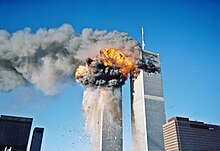
Back انتحار من قبل الطيار Arabic Pilotensuizid German خودکشی میان خلبانان Persian Suicide par pilote French התאבדות של טייס HE पायलट द्वारा आत्महत्या Hindi Bunuh diri pilot ID 操縦者による自殺 Japanese 자살비행 Korean Suicídio do piloto Portuguese


Suicide by pilot is an aviation event in which a pilot deliberately crashes or attempts to crash an aircraft as a suicide act, with or without the intention of causing harm to passengers on board or people on the ground. If others are killed, it may be considered a type of murder–suicide.[1] It is suspected to have been a possible cause in several commercial flight crashes and has been confirmed as the cause in other instances. Determining the motives of pilots can be challenging for crash investigators, as pilots may intentionally disable recording devices or engage in other actions to impede future investigations.[2] Consequently, definitively proving pilot suicide can be difficult.[3][4]
Investigators do not classify aircraft incidents as suicides unless there is compelling evidence indicating that the pilot intended suicide. This evidence may include suicide notes, past suicide attempts, explicit threats of suicide, or a documented history of mental illness. A study conducted on pilot suicides between 2002 and 2013 identified eight cases as definite suicides, along with five additional cases of undetermined cause that may have been suicides.[5] In some cases, investigators may collaborate with terrorism experts to investigate potential connections to extremist groups, aiming to ascertain whether the suicide was an act of terrorism.[6][7][8]
A Bloomberg News study conducted in June 2022, focusing on crashes involving Western-built commercial airliners, revealed that pilot murder-suicides ranked as the second most prevalent cause of airline crash deaths between 2011 and 2020. Additionally, the study found that deaths resulting from pilot murder-suicides increased over the period from 1991 to 2020, while fatalities due to accidental causes significantly decreased. However, most cases of suicide by pilot involve general aviation in small aircraft, where typically the pilot is the sole occupant of the aircraft. In approximately half of these cases, the pilot had consumed drugs, often alcohol or antidepressants, which would typically result in a ban on flying. Many of these pilots have concealed their mental illness histories from regulators.[5]
- ^ Charles Bremner (Paris), March 26, 2015, The Times, Locked door boosts pilot suicide theory Archived March 27, 2015, at the Wayback Machine. Retrieved March 26, 2015
- ^ Richard Lloyd Parry, December 16, 2000, The Independent, "Singaporean air crash that killed 104 was suicide by pilot, say investigators" Archived September 25, 2015, at the Wayback Machine. Retrieved March 26, 2015, "...An airliner which crashed into an Indonesian swamp, killing all 104 people on board, was an apparent suicide attempt by the pilot, ... the cockpit voice and data recorders had been switched off half a minute before the aircraft began its descent."
- ^ Young, Toby (March 16, 2014). "Could a four-year-old thriller unlock the mystery of flight MH370?". The Daily Telegraph. Archived from the original on March 4, 2016. Retrieved March 26, 2015.
...If this was a case of "suicide-by-pilot", why do we still know so little about the motive? ...
- ^ March 31, 2014, The Guardian, MH370: authorities release new account of pilot's final words: Malaysia's civil aviation authority say pilot's final words heard by air traffic control were 'goodnight Malaysian three seven zero' Archived April 10, 2017, at the Wayback Machine. Retrieved March 26, 2015, "...Malaysia says the plane, which disappeared less than an hour into its flight, was likely to have been diverted deliberately far off course. Investigators have determined no apparent motive or other red flags among the 227 passengers or the 12 crew. ..."
- ^ a b Lewis, Russell; Forster, Estrella; Whinnery, James; Webster, Nicholas (February 2014). "Aircraft-Assisted Pilot Suicides in the United States, 2003-2012" (PDF). Civil Aerospace Medical Institute. NTL.BTS.gov. Federal Aviation Administration. Archived (PDF) from the original on April 3, 2015. Retrieved March 29, 2015.
- ^ March 2015, The Independent, ... Co-pilot of crashed Germanwings flight 9525 'wanted to destroy plane in suicide and mass murder mission' Archived September 25, 2015, at the Wayback Machine
- ^ Jane Onyanga-Omara, January 19, 2015, USA Today, No evidence of terrorism in AirAsia crash Archived August 21, 2017, at the Wayback Machine. Retrieved March 27, 2015, "...Investigators have found no evidence so far that terrorism was involved in the crash of AirAsia Flight 8501, ..."
- ^ March 27, 2014, The New Zealand Herald, Flight MH370: Terrorism expert backs theory of pilot suicide flight Archived February 22, 2015, at the Wayback Machine. Retrieved March 27, 2015, "...University of Canterbury Professor Greg Newbold, who lectures on terrorism, said the only person who could have changed MH370's computerised flight plan and switched off its electronics was someone who was highly experienced...."